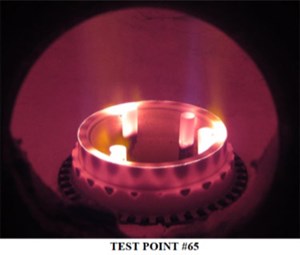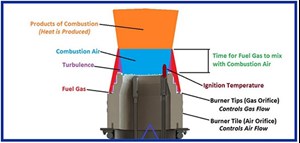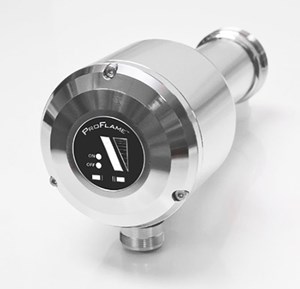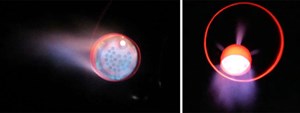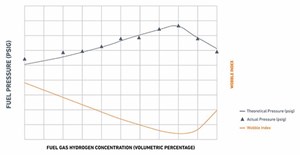Articles
End-to-end H2 firing solutions
H2 Equipment and Services
P. IMEL, Zeeco, Chandler, Oklahoma; C. FILOON, Zeeco, Broken Arrow, Oklahoma and C. PARKER, Zeeco, Tulsa, Oklahoma
To meet corporate and global net-zero carbon initiatives, many refining and chemical industry plant owners are considering refueling existing fired equipment with sustainable, low-carbon fuels. One such fuel is hydrogen (H2), which can be produced through renewable energy sources (green H2) or by reforming natural gas (blue H2).
Once produced, H2 can be injected into existing fuel gas networks to produce high-H2 blends or used in pure form for fueling fired heaters and process furnaces. As H2 displaces hydrocarbons in fuel composition, the amount of carbon atoms decreases. A fuel stream composed of 100% H2 will not generate carbon monoxide (CO) or carbon dioxide (CO2) as a byproduct due to the lack of carbon in the combustion reaction. Therefore, the higher the H2 content of a fuel, the lower the overall CO and CO2 emissions.
Due to the vastly different combustion characteristics of H2 compared with conventional hydrocarbon fuel gases, plant owners and operators must consider several challenges. Understanding these considerations, from burner construction to controls and monitoring while firing, will help organizations embrace how high-H2 fuels can support the transition to carbon neutrality (FIGS. 1 and 2).
Design challenges. Most fired heaters and process furnaces were designed for firing natural gas or refinery fuel gases that contain a high proportion of hydrocarbons, H2, inert gases and traces of other compounds. The typical H2 content for refinery fuel gas may vary between 20 vol% and 40 vol%. When refueling burners to fire high H2, H2 concentrations of 90 vol%–100 vol% are probable. This concentration of H2 changes the operating parameters of the burner, requiring adaptations to the burner design to ensure heater operation is not detrimentally affected.
The laminar flame speed of H2 is significantly higher than hydrocarbon fuels, resulting in a more rapid combustion process and increased heat release per unit volume. The flame speed in H2 combustion is approximately 1.7 ft/sec, while the flame speed of natural gas is significantly slower at only 0.4 ft/sec. H2 firing has a higher stoichiometric adiabatic flame temperature of 3,960°F, while natural gas has an adiabatic flame temperature of 3,518°F. H2’s high flame propagation speed allows the combustion process to occur more rapidly than natural gas. This rapid combustion process releases the combustion energy in a small area, leading to localized elevated near-flame region temperatures, which compound the effect of the inherently high adiabatic flame temperatures on nitrous oxide (NOX) emissions rates. Any region with elevated temperatures (> 2,500°F) is conducive to NOX formation. Field and test facility data have shown that standard low-NOX burners firing H2 typically exhibit an increase in NOX emissions rates by up to a factor of three. Therefore, employing ultra-low NOX burner technologies is usually necessary to remain within legislative NOX emissions requirements when firing high-H2 fuel.
These significant differences in combustion characteristics translate to burner engineering and design considerations. For example, typical burner construction includes various metal components and a refractory throat or tile. The increased flame temperature of H2 requires upgrading the steel used for nozzle construction, throat construction and flame stabilizers to a higher-grade stainless or alloy. The refractory used within the burner should be carefully evaluated, and its composition should be modified to withstand the elevated temperatures characteristic of H2 firing. The steel in burners firing H2 should not be susceptible to H2 embrittlement and high-temperature H2 attack. Both phenomena can prematurely degrade an improperly chosen steel, leading to early failure of the burner parts.
Increasing the H2 content in the fuel gas decreases the lower heating value of the fuel on a volumetric basis. Consequently, increasing the fuel gas pressure is often necessary to achieve the same burner heat release. Therefore, burner gas tip design and fuel gas piping hydraulics should be assessed and re-sized. Additionally, existing heater safety interlocks and trip settings must be reviewed and amended as appropriate for high-H2 fuel. For example, furnace tunable diode laser (TDL) systems and flame scanners with ultraviolet/infrared (UV/IR) detection may no longer be suitable and alternative technologies capable of detecting high-H2 flames may merit consideration.
BURNER CONSIDERATIONS FOR HIGH-H2 FUELS
Diffusion-type or pre-mixed-type burners present different challenges when firing a high-H2 fuel; therefore, each type of burner will be discussed separately.
Ultra-low NOX diffusion burners. One successful option for firing high-H2 fuels without high NOX is an ultra-low NOX-free burnera that utilizes internal flue gas recirculation to recondition fuel gas with inert products of combustion prior to mixing it with combustion air. The reconditioned fuel mixture prolongs the combustion reaction, thus reducing peak flame temperature and thermal NOX production. This burner can achieve NOX emissions of less than 50 milligrams per cubic meter (mg/m3) on 90% H2 fuel without steam injection or post-combustion emissions control (FIG. 3).
The principle relies on converting fuel gas momentum ejected from the tips to entrain flue gas. To achieve this, discrete high-velocity gas jets are injected through a ring of gas tips on the outside of the tile. The gas jets help to counteract the high flame speed of H2 flames, ensuring a stable and robust flame over a wide operating range. Another consideration when firing high-H2 fuel gas is using a burner with low-mass gas tips. In the NOx-free burnera example, the gas tips protrude through the furnace floor less than 25 millimeters (mm), so the thermal intensity over the gas tip profile is significantly reduced. This means the gas tips are suitably designed to withstand the elevated temperature characteristics of H2 firing with an extended operating life (FIG. 4).
Ultra-low NOX pre-mixed radiant wall burners. Pre-mixed radiant wall burners are commonly used in ethylene-cracking furnaces and present a different challenge when firing high-H2 fuels due to the propensity for flashback. Due to this, burner designers must consider the flammability window and flame speed of each specific fuel composition. The flammability window of pure methane (CH4) is between 5% and 17%, with a flame speed of 1.3 ft/sec. This means that when mixed with air at a concentration of 5%–17%, CH4 will support combustion at that speed. The flammability window for H2 is between 4% and 74%, with a flame speed of 5.7 ft/sec.
As higher H2 concentrations in fuel gas become more common, it becomes increasingly difficult to design burners with exit velocities to overcome this flame speed increase. One common requirement is for a burner to operate successfully on natural gas and a high-H2 blended fuel. If the designer gets this balance wrong, the flame will propagate inside the burner, also known as a flashback. Flashback situations can degrade the mechanical integrity of the burner components and increase thermal NOX emissions.
To overcome this technical challenge, the author’s company developed a radiant wall burner design capable of firing more than 90% H2 fuel combinations while producing less than 100 mg/m3 of NOX emissions. A proprietary fuel staging design produces two separate mixture zones exiting the tip. This combination enables the burner to generate the exit velocity needed in the lean zone to prevent flashback while delaying combustion in the rich zone long enough to mix the fuel gas with inert flue gas products to lower the adiabatic flame temperature and reduce NOX formation. This burner design has proven to work even in challenging high-H2 fueled furnace applications with extremely tight burner-to-burner and burner-to-tube spacing while still meeting the < 100mg/m3 emissions requirement.
Flame scanners. Conventional flame scanners are configured to detect combustion radiation in the UV visible and IR spectrum. The exact spectral ranges are based on wavelengths characteristic of the combustion of hydrocarbon fuels. The UV plus IR components vary depending on the specific type of fuel used. Therefore, conventional scanners have wide spectral ranges, enabling operation on various gaseous and liquid fuels.
When firing high-H2 fuels, the absence of carbon means the spectral range of radiation produced by the combustion process is significantly narrowed and shifted toward the UV spectrum. Therefore, scanners that rely on UV plus IR spectral ranges experience weakened peak flame signals, leading to nuisance trips.
In addition, some discussion of UV as emitted by the flames from the various available fuels is necessary since the UV release is a byproduct of combustion occurring when the diatomic oxygen (O2) molecule is dissociated. Typically, the dissociated O2 molecule will undergo reassociation with the parts of the dissociated hydrocarbon (CxHx) molecule, forming CO, CO2, nitric oxide (NO), nitrogen oxide (NO2) and water (H2O). Firing H2 forms significantly more H2O because carbon decreases with an increase in the H2 fuel stream. The increase in H2O as the byproduct of combustion with H2 firing presents the common problem of UV absorption from the water vapor byproduct, reducing flame detection. There is a UV re-emission point at the hydroxyl, and it occurs at a specific wavelength.
UV tube-based sensors quickly get blinded by the H2O production from a high-H2 fuel stream, and their spectral response completely misses this UV re-emission point. Solid-state UV sensors’ spectral response typically covers the UV re-emission point but are too broad in their response or are optically filtered, leading to a significant decrease in response at this point. The author’s company’s scanner’s sensorb is specifically optimized to work at this UV re-emission point, even at 100% H2 firing.
The other aspect of H2 firing is that the flame propagation speed is much higher than that of hydrocarbon-based fuels. This increase in flame speed leads to a much higher flicker frequency or combustion rate when firing H2 fuels. In a multiple burner environment, the flicker frequency is used to assist in the differentiation of the target flame from all background flames. A scannerb with a flicker frequency setting easily differentiates the target flame from other flames in the furnace, allowing for the safe operation of the unit during firing scenarios.
The burner flame may become much shorter when firing high-H2 fuels due to increased flame speed. Therefore, properly sighting the flame scanner is important to ensure it is aligned with the target flame. This will reduce the chance of unwanted background signals being detected by the flame scanner (FIG. 5).
Pilots. Most pilots used in fired heaters are self-aspirated, meaning the air is naturally induced for mixing with fuel gas before combustion. When firing high-H2 fuel in pilots, the chance of flashback inside the pilot tube increases. This can cause damage to the pilot itself and any internal components.
The author’s company’s pilot designsc are capable of firing on pilot gas compositions of up to 90% H2 without flashback and are advantageous in a high-H2 environment. When operating on high-H2 fuel, the adjustable air door can be manually adjusted to control airflow and prevent flashback. As the H2 content increases, the air door must be closed further to maintain the jet speed and prevent flashback (FIG. 6).
The pilotsc are designed to be operated on a wide range of fuel gas compositions, without replacing or modifying the pilot. For pilots firing > 90% H2 fuel, a diffusion-type or forced-air pilot can provide a stable ignition source for the main burner.
Pilot flame detection. Many burner pilots on fired heaters are equipped with flame/ionization rods for pilot flame detection. Flame rods work due to the ionization/rectification process to complete an electrical circuit. When the flame rod is energized, the current produces a positive charge that attracts negative ions in the flame. The positive ions produced in the combustion process are attracted to the grounding area of the pilot tip. By attracting more positive ions to the ground, the flow of electrons is rectified and flows in one direction. This produces the direct current signal that is used to indicate the presence of a flame.
The flame must comprise many ions for the ionization system to function properly. H2 flames produce fewer ions than organic compounds, so a weak current is generated that cannot be detected by the flame ionization module. Therefore, flame rods are not a suitable method of pilot flame detection for high-H2 fuels, and alternative means of pilot flame detection should be considered.
One method of pilot flame detection is the use of a flame scanner that is mounted to the rear end of the pilot. The flame scanner is sighted on the pilot tip to detect the flame. The pilot tip shield can be specially modified, preventing the flame scanner from detecting a signal from the main burner flame.
Data review. Actual test data is necessary to move theoretical discussions regarding H2 refueling to real-world applications. For example, data collected regarding firing varying H2 concentrations in fuel gas shows some interesting results. The first review area regards fuel pressure when transitioning from 100% natural gas to 100% H2 firing while maintaining the same burner heat release. FIG. 7 includes a curve of theoretical pressure drop across burner tips vs. the H2 percentage in the fuel.
Note that the remaining percentage balance is natural gas. The measured pressure drop across the burner tips vs. the H2 percentage is plotted on the same scale. Before reviewing this curve and actual data, many think 100% H2 will result in the highest fuel pressure as the heating value per volume decreases with increasing H2. As shown in FIG. 7, the theoretical and actual pressures peak before reaching 100% H2. The Wobbe Index was plotted on the same figure to help illustrate the phenomena. Since the fuel pressure drop is related to flow and density, the Wobbe Index indicates how the fuel pressure drop will trend with different gases. It does not indicate combustion property changes, only an indication of pressure drop variance.
Another area of data review is NOX emissions because thermal NOX is formed due to localized peak temperatures occurring in the flame zone with enough residence time to decompose diatomic nitrogen. As the adiabatic flame temperature increases, so does the propensity of the burner to generate increased thermal NOX. As shown in FIG. 8, the measured NOX emissions for a conventional raw gas burner are compared to measured NOX emissions from an ultra-low, NOx-free burnera with varying concentrations of H2 in the fuel gas.
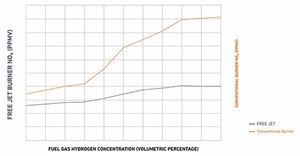
The increase in NOX emissions for a conventional burner is significantly higher than that of an ultra-low, NOX -free burner. This is due to internal flue gas recirculation and other proprietary design methods to reduce flame temperature peaks within the combustion zone. While increasing H2 results in higher NOX emissions, burner technology and design methods can reduce the NOX impact compared to older equipment.
Only a few considerations must be analyzed to ensure the safe firing of H2 while meeting the environmental limits of the operating jurisdiction. Consultation with an experienced burner supplier well-versed in H2 firing is essential to ensure success.H2T
Notes
a ZEECO Ultra-low NOX FREE JET™
b ZEECO ProFlame™ sensor
c Zeeco’s JM-1S and SM-1S pilots
About the authors

PARKER IMEL is the Manager of Burner Process Design for Zeeco. He began his career at Zeeco in 2009 as a Test Facility Engineer. Since then, Imel has taken on many roles at Zeeco, including Senior Process Design Engineer for the burner group, supporting process burners, retrofits and duct burners. Imel is from Chandler, Oklahoma, and earned a BS degree in mechanical engineering from Oklahoma State University.

CHRISTOPHER FILOON is the Director of Combustion Electronics for Zeeco. He has more than 20 yr of experience in proper flame detection in various combustion environments, including understanding the rules and regulations concerning safe flame detection for worldwide markets. Filoon lived and worked for Zeeco in Singapore for 3 yr and in Germany for 4 yr. He has also held various leadership positions working with flame detection in the U.S.

CHRIS PARKER was born and raised in Tulsa, Oklahoma (U.S.) and obtained his BS degree in mechanical engineering with a minor in petroleum engineering from Oklahoma State University. He has been involved with the combustion industry as an employee of Zeeco for 12 yr. During his time at Zeeco, Parker has worked as a test facility engineer in Zeeco’s test facility for 3 yr, applications engineer for 7 yr and applications engineering manager for 2 yr.

